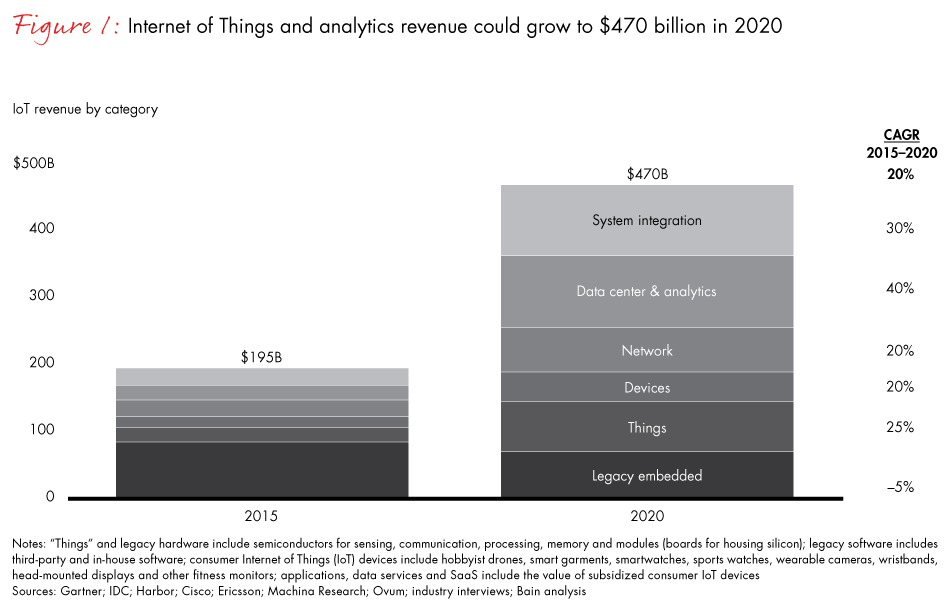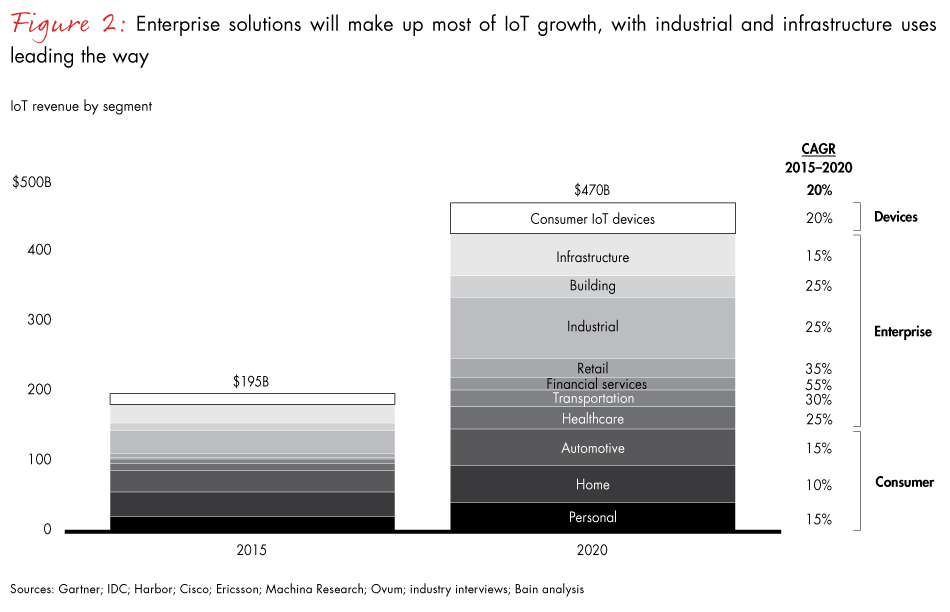Brief

When telecom executives look for opportunities in the Internet of Things (IoT), they frequently look up.
Up the stack, that is. That’s where commercial customers will look for solutions that enable them to manage billions of connected devices and generate value with the data that flows from those devices. Telecom executives see this enormous opportunity and wonder how they can capture value by developing industry-specific offers for their customers.
This ambition is understandable and commendable, given the potential of IoT, which we estimate will generate more than $470 billion in annual revenues by 2020—a significant amount of which will come from selling industry-specific services (see Figures 1 and 2). Competition will be fierce, and major telcos have already shown that they are willing to invest billions to capture the opportunity. Verizon, for example, recently acquired Fleetmatics and Telogis, two companies in the fleet-management and telematics space.
Some vertical markets or segments where it’s logical for telcos to enter and compete are quickly becoming crowded. Smart homes, for example, are also drawing investment from cable TV providers, home security firms, mobile device manufacturers and other tech behemoths, including Amazon, Facebook, Google and Microsoft.
However, telcos tend to focus too heavily on vertical solutions, underplaying their hand in two large, horizontal spaces where they enjoy the right to compete and win. First, only telcos have the necessary experience to deliver scale connectivity solutions at the center of the IoT. Second, telcos are also the only players with experience managing extensive directories and the life cycles of millions of devices. They also have a strong position developing and managing analytics at the edge of the network across a range of industries and uses. These strengths, combined with their trusted status, leave telcos uniquely qualified to facilitate the delivery of IoT solutions.


Together, these advantages provide telcos with a three-layered opportunity they can use to develop unique, differentiated strategies for the IoT:
- Connectivity includes the network that interconnects billions of devices with analytics engines and massive data warehouses. This layer also includes network services—such as quality-of-service guarantees and pricing plans that support the IoT—along with the ability to run analytics engines in the network to manage data flows more effectively and to accelerate response time.
- Life cycle management is the ability to manage the complex cycle of device enablement, authentication, management, maintenance and replacement in a way that ensures network security, device directory maintenance and rights management. Such management often takes place years after the devices are installed and spans a universe of devices that is much larger than other suppliers typically manage.
- Vertical solutions are the industry-specific offers that deliver value to enterprises and consumers. Telcos may choose to participate directly or facilitate, through the underlying layers, vertical solutions that others provide.
The value at stake in the network and gateway battleground
To better understand the opportunities in the IoT, Bain looked at the various overlapping IoT markets, as well as their connections to one another across the consumer, enterprise, industrial and public sectors. Through this research we defined five major battlegrounds, each with unique competitive dynamics, rules of engagement, growth opportunities and profit pools. (For more details, see the Bain Brief “Defining the Battlegrounds of the Internet of Things.”)
At the center of these battlegrounds sits network connectivity, the starting point for building the IoT opportunity for any telco. Here, telcos’ deep expertise lays the foundation to take more than their fair share of business. Only telcos have the experience and capabilities to deliver carrier-grade networks that meet compliance requirements and governance demands across a global range of regulatory schemes. They are building software-defined, virtual networks that can offer flexibility in terms of service suites and various security and performance levels. This flexibility will be essential in allowing clients to automatically self-provision when necessary or enabling integration with third-party systems through appropriately monitored APIs.

How Telcos Can Win in the Internet of Things
Network service providers can succeed in the IoT by focusing on three areas.
The opportunity in life cycle management stems from telcos’ deep expertise in deploying, maintaining and decommissioning the millions of devices on their networks. Most telco executives are aware of their expertise in managing devices like mobile phones and tablets, which have a SIM card and link directly to an individual account. However, an even larger opportunity comes from managing the billions of devices without SIM cards, lying behind gateways, such as controllers on a factory floor or thermostats in private homes.
In these early days of the IoT, the focus is on developing and deploying the initial device infrastructure. Few are thinking about the scale of IoT devices after deployment or the massive effort that will be involved in managing these billions of devices through their effective lives. Top-down estimates for commissioning, maintaining, upgrading and decommissioning these devices could be more than $28 billion globally by 2020.
Telcos also have a clear opportunity to develop platforms that other industrial and consumer companies can use to manage their devices. Telcos could operate the directory and registry for devices, while also managing maintenance, upgrades and decommissioning. For industrial and commercial businesses that sell vertical solutions, a life cycle-management platform—with a trusted telco brand on the label—could be a significant selling asset.
Based on their advantaged position in the connectivity and life cycle layers, telcos could also assemble vast data lakes of interesting information, and then make that information available to vertical market-solutions providers. Telcos could also furnish infrastructure embedded in the network (operated by the telco or by others) where analytics engines reside, allowing analytics to be performed at the edge. The benefits would include faster response times and better control of which information does—or doesn’t—flow into the network.
When well executed, telcos are in the best position to build powerful platforms that enable vertical market solutions. In some cases, telcos will deploy these solutions themselves; more frequently, though, they will support third-party solutions on telco-provided IoT platforms.
Prioritizing vertical opportunities
Successful deployment at the connectivity and life cycle layers supports success further up the stack, in the vertical solutions developed for clients in specific industries. But as with any broad new opportunity, telcos need to thoughtfully choose where they participate directly and where they facilitate the success of other vertical market-solutions providers. Telcos that choose to build up their capabilities in only a few industries stand a better chance of succeeding than those that enter too many verticals at the same time. (For more information, see the Bain Brief “How Providers Can Succeed in the Internet of Things.”)
Executive teams can start this decision process by assessing their unique assets and mapping them to specific opportunities. With a clear understanding of their relative strengths, telcos should be able to determine which opportunities most closely align with their capabilities. By resisting the temptation to over-extend—and instead investing in three or four of the most promising possibilities—telcos can materially increase the likelihood of success while improving industry credibility and trust.
Even after identifying their competitive advantages, telcos need to reinvent some capabilities to become competitive with their industry offers. In some cases, telcos will need to partner with or acquire other companies to obtain the industry expertise and capabilities needed to succeed.
First-mover advantage
Even as they partner to gain capabilities for vertical solutions, telco executives should focus on taking full advantage of their core network assets and capabilities. Leaders in the field are already building IoT-enabled platforms at the connectivity and life cycle management layers to head off third-party service providers from working directly with their customers. In this way, these telcos can either selectively add highly differentiated vertical offers or facilitate third-party vertical offers where differentiation is more difficult or the investment needed is too great.
Rebalancing toward IoT-enablement services—and away from excessive enthusiasm over vertical solutions—should provide significantly more success for telcos around the world.
Connectivity and life cycle management are inherently platform plays in the IoT, and only a limited number of telcos will see their platforms widely adopted. Those that are first to market will also capture deep knowledge about how to plan future network architectures and will develop the new skills and capabilities necessary to win as the market evolves. The need to move quickly is imperative.
Herbert Blum leads Bain & Company’s Telecommunications practice in the Americas. He is based in Toronto. Darren Jackson is a Bain partner based in Los Angeles. Velu Sinha and Paul Smith are partners in Bain’s Silicon Valley office, and Paul leads Bain’s Global Telecommunications practice.
The authors would like to thank Ann Bosche, David Crawford and Michael Schallehn, Bain partners in San Francisco and Silicon Valley, respectively, for their contributions to this work.